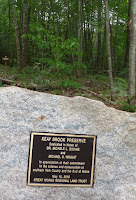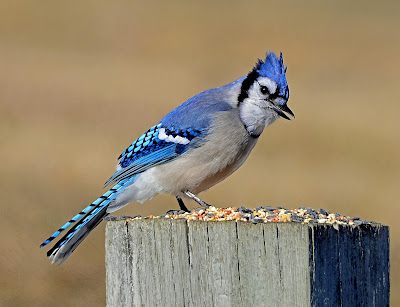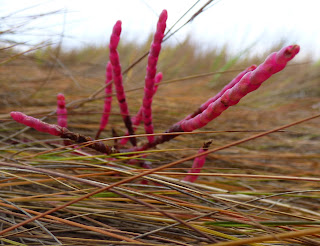 |
| Dedication marker |
Nature Walk
Keay Brook Preserve Nature Walk
I recently led a nature walk for the
North Berwick Historical Society at the newly-opened
Keay Brook Preserve . This Great Works Regional Land Trust property comprises a total of 86 acres on the Salmon Falls River in Berwick. The Keay Brook Preserve contributes to a total 229-acre block of conserved land along the Salmon Falls River-instrumental in protecting water quality and wildlife habitat.
In this post I will attempt to reproduce our discussion as we walked the 1+ mile trail (in a clockwise direction).
Parking Lot
 |
| Opposite branching of a witherod bush |
We began in the parking lot with a discussion of tree identification--I'm no expert, but know some basic rules to begin any identification of trees. First thing is to decide whether a tree is a conifer (needle-bearing) or broad-leaved. Second thing to look for is whether the branches are arranged in an opposite or alternate fashion. Opposite means two branches come out from one node-opposite to each other. Alternate arrangement is when branches alternate sides along a main trunk or branch. In the photo to the left, the arrow is pointing to the branch point of the oppositely arranged leaves of a witherod bush. In the photo below the arrows are pointing to the alternating leaves of a basswood. A fun way s to remember which trees are opposite is the acronym MADCapHORSE.
Maples,
Ash,
Dogwood and
Horsechestnut have opposite leaves/branching patterns. The 'Cap' stands for the
Caprifoliaceae (a beautiful word that is incredibly fun to say) family--these are the honeysuckles and viburnum--mostly shrubs and vines.
 |
Alternate branching of basswood
|
The parking lot is surrounded by towering white pines. There is a dedication marker and a gate with trail maps.
Northern Red Oak As you leave the parking lot you will encounter northern red oak trees. One of the largest trees in the
Northeast. Northern red oaks are also one of the northernmost oaks (Bur oak
grows slightly farther into Manitoba Canada). They were so loved by early colonists that they have been planted in England and western Europe and are now naturalized in those areas.
 |
| Bristle-tips of red oak leaves |
Northern red oaks are in the red oak group--which includes
black oak,
scarlet oak, and pin oak. The leaves have bristle tips-the vein of the leaf extends out beyond the margin forming a needle-like projection. The acorns take two years to develop and will fall just before the leaves so they are buried by the leaves and somewhat protected from predators--they'll overwinter and germinate in the spring. Their high tannin content also helps protect them.
We discussed 'Mast years'--those years when large numbers of acorns are produced. The group agreed that they happen approximately every 5 years around here, but different factors are at work, so the general rule of thumb is every 2-5 years. For more on this see Nature News World.
 |
| Wolf pine |
White Pine On the right-hand side of the trail is a nice example of a growth form of white pine known as a wolf pine. Some members of the group knew these as candelabra pines or bull pines. White pines are majestic trees that usually grow tall and straight--a reason they were so desired by the early settlers for ships' masts. However, when they are young and exposed to sufficient sun the white pine weevil will lay its eggs at the tip of the stem, at the top of the tree, disrupting that tall, straight growth in favor of horizontal branches. Called the wolf tree perhaps because of its lone wolf nature-that early growth happened in the sun, not surrounded by other white pines. Bull pine I'm not sure on but would guess it has something to do with these trees being left alone in pastures to provide shade for livestock. Candelabra--that's easy-it looks like one! If you want to know more about these trees check out Northern Woodlands 2013 article








Comments
Post a Comment